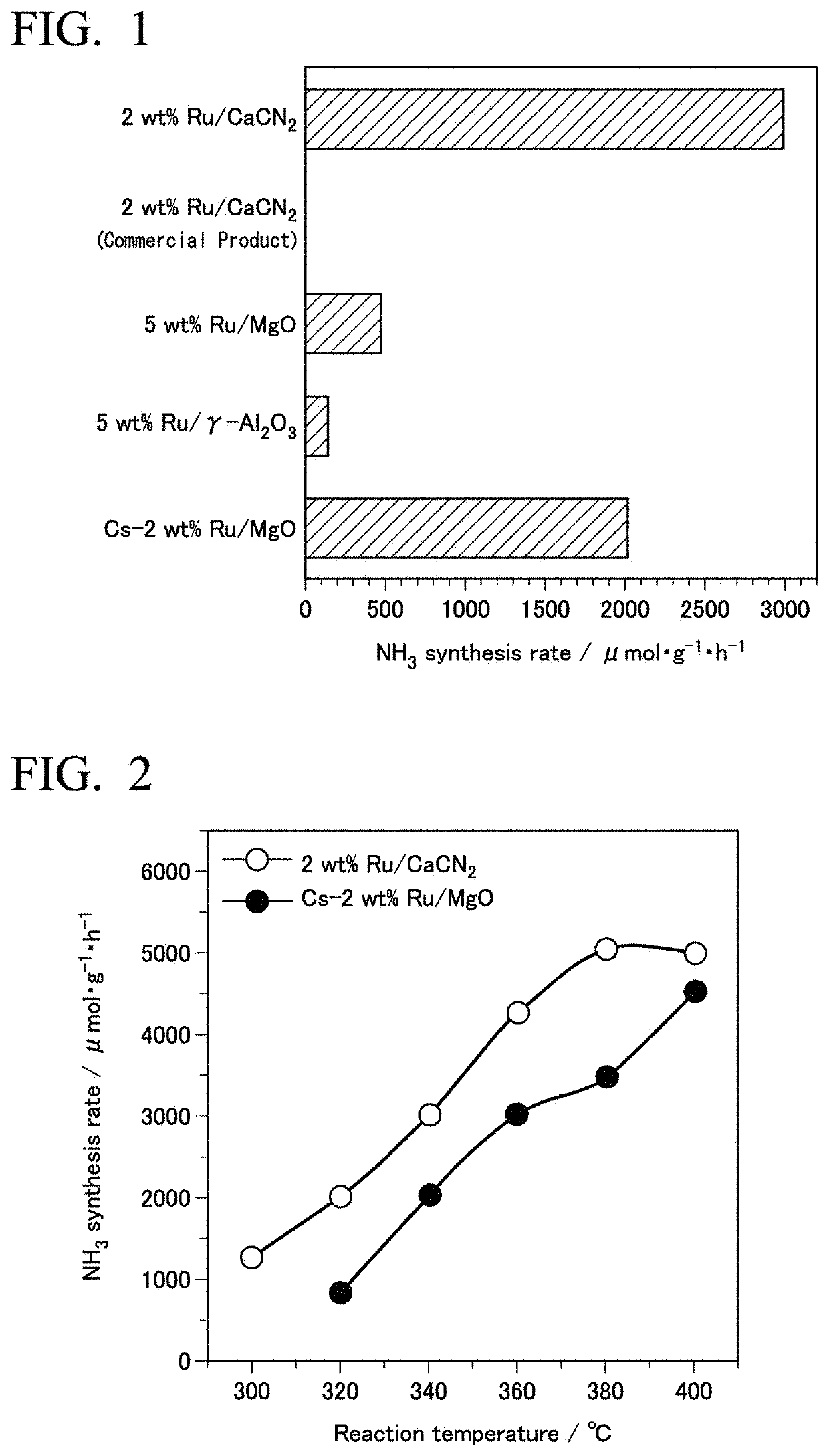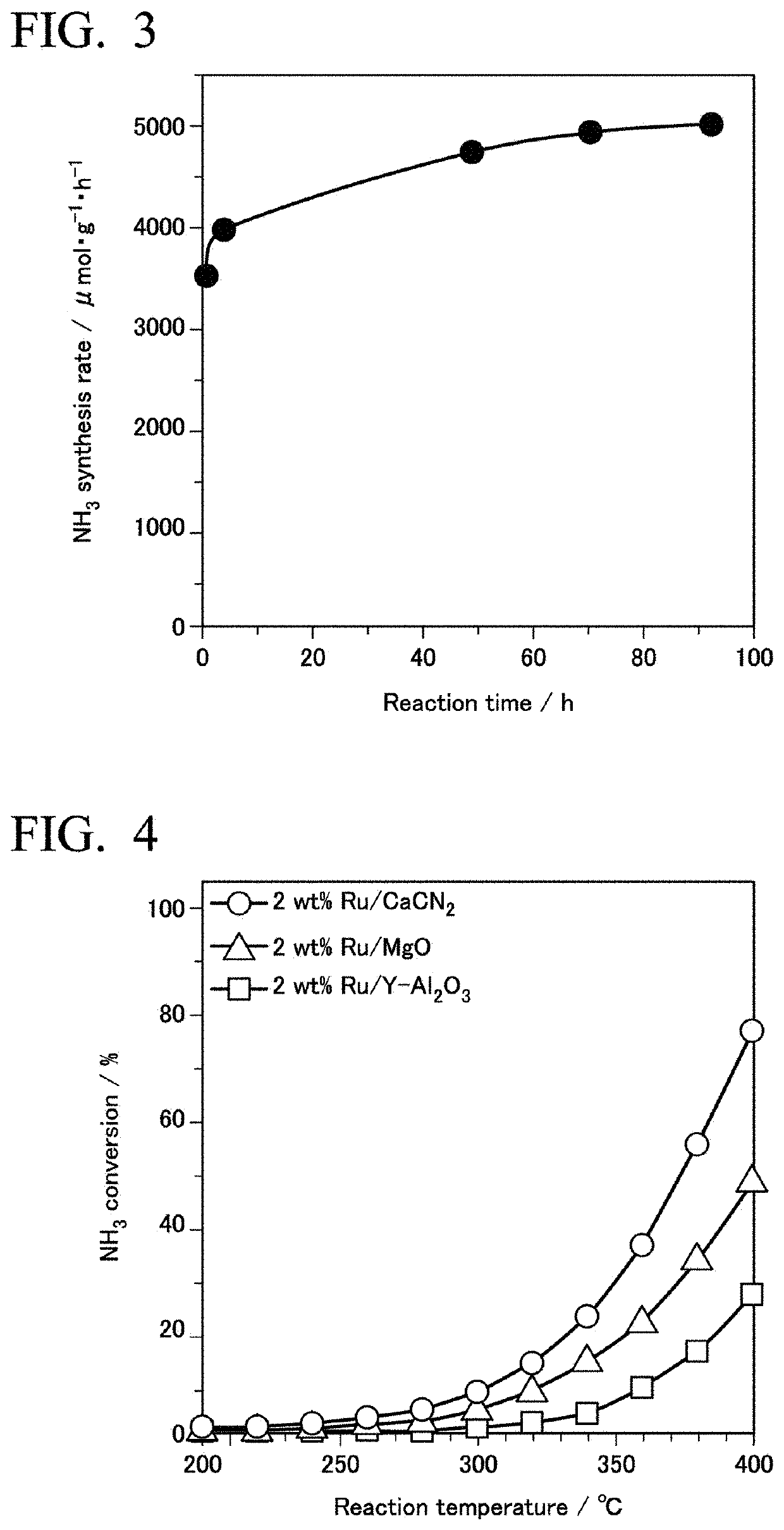Supported metal material, supported metal catalyst, method of producing ammonia, method of producing hydrogen and method of producing cyanamide compound
a metal catalyst and supported metal technology, applied in the direction of catalyst activation/preparation, metal/metal-oxide/metal-hydroxide catalyst, physical/chemical process catalyst, etc., can solve the problem of low reaction activity of catalysts, insufficient performance for practical use, and high equipment and cost. problems, to achieve the effect of low reaction pressure, low energy consumption and reduced catalytic activity
- Summary
- Abstract
- Description
- Claims
- Application Information
AI Technical Summary
Benefits of technology
Problems solved by technology
Method used
Image
Examples
example 1
[0247]2>
[0248]CaCN2 was synthesized by heating CaCO3 (manufactured by Kojundo Chemical Laboratory Co., Ltd., powder, BET specific surface area: 3.1 m2g−1) at 550° C. for 20 hours under NH3 flow (100 mL / min). The obtained CaCN2 was in the form of powder, and the BET specific surface area was 6.4 m2g−1. The purity of CaCN2 (the content of CaCN2 in the reaction product) was 98.7 wt %. And as other components, the content of CaCO3 was 0.6 wt % and the content of CaO was 0.7 wt % as other components.
[0249]2 Loaded with Ru>
[0250]1 g of CaCN2 synthesized by the above method was mixed with 0.042 g of Ru3(CO)12 (manufactured by Aldrich, powder form) in a glove box under an Ar atmosphere, and then sealed in an evacuated silica tube. The temperature of the mixture sealed above was gradually raised to 250° C. while being rotated, and then heated at the same temperature for 2 hours. 2 parts by weight of metal Ru particles were supported on CaCN2 with respect to 100 parts by weight of CaCN2 (here...
example 2
[0253]CaCN2 was synthesized in the same manner as in Example 1, except that instead of CaCO3 used in Example 1, Ca(CH3COO)2.H2O (manufactured by Kanto Chemical Co., Ltd., powder form) was heated at 550° C. for 20 hours under NH3 gas flow. The obtained CaCN2 was in the form of powder, and its BET specific surface area was 15.0 m2g−1.
[0254]2 wt % Ru / CaCN2 catalyst was prepared in the same manner as in Example 1 using the obtained CaCN2. The BET specific surface area of the catalyst was 18.1 m2g−1. The Ru dispersion measured by the CO adsorption method was 16.3%.
[0255]An ammonia synthesis reaction was carried out under the same conditions as in Example 1 using the supported Ru material as a catalyst. The synthesis rate of ammonia at 340° C. was 2.9×103 μmol·g−1h−1. The TOF was 24.6×10−3s−1. The results are shown in Table 1.
example 3
[0265]0.5 wt % Ru / CaCN2 was prepared in the same manner as in Example 1 except that the loading amount of Ru of the supported Ru material described in Example 1 was changed to 0.5 parts by weight.
[0266]The ammonia synthesis reaction was carried out under the same conditions as in Example 1 using this supported Ru material as a catalyst. The synthesis rate of ammonia at 340° C. was 0.5×103 μmol·g−1h−1. The results are shown in Table 2.
PUM
| Property | Measurement | Unit |
|---|---|---|
| specific surface area | aaaaa | aaaaa |
| temperature | aaaaa | aaaaa |
| temperature | aaaaa | aaaaa |
Abstract
Description
Claims
Application Information
 Login to View More
Login to View More - R&D
- Intellectual Property
- Life Sciences
- Materials
- Tech Scout
- Unparalleled Data Quality
- Higher Quality Content
- 60% Fewer Hallucinations
Browse by: Latest US Patents, China's latest patents, Technical Efficacy Thesaurus, Application Domain, Technology Topic, Popular Technical Reports.
© 2025 PatSnap. All rights reserved.Legal|Privacy policy|Modern Slavery Act Transparency Statement|Sitemap|About US| Contact US: help@patsnap.com


